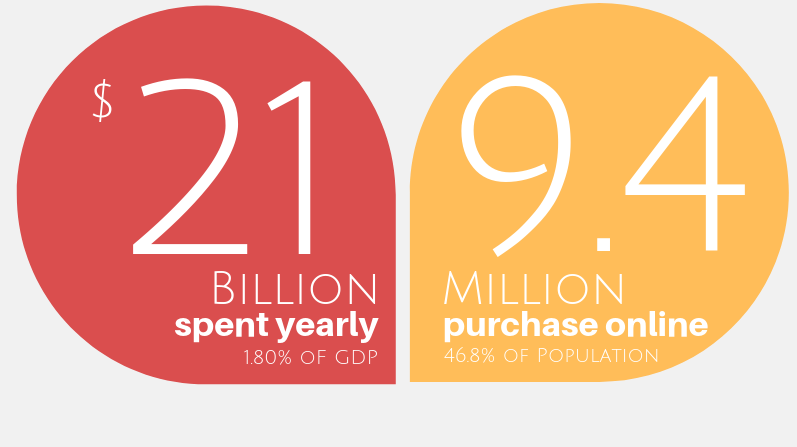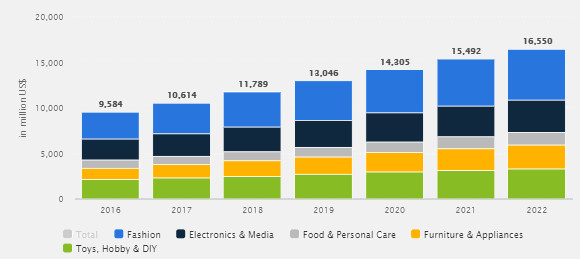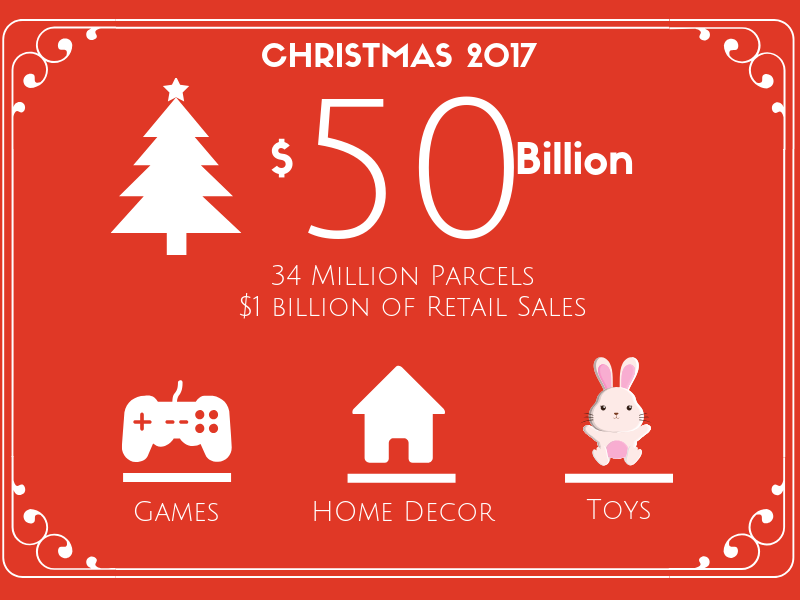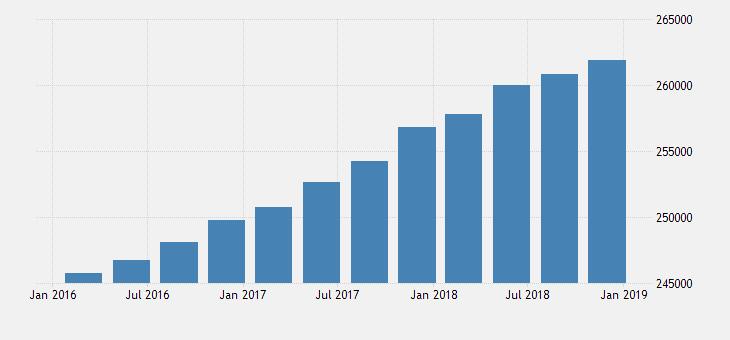The economical living standards in metropolitan districts of Australia have skyrocketed to $2,150 per month from $1800. The highest spending levels are forecasted in Sydney and Melbourne. As quoted by Australian NAB, “Average monthly spending was highest in Sydney, marginally ahead of Victoria. Perth was next, followed by Brisbane, Adelaide and Hobart.” Consider this statistical information depicted below about the rocketing of Australian consumer spending to 260656 AUD Million since 2016.
Average Household Expenses Of An Australian Family
So how much does the average Australian spend in a year? MoneySmart.au estimates that the average household in the country spent $74,301 in 2016. With the flow of advancement, Aussies spent more on meals and foods than electricity and transport. According to the country’s bureau of statistics, the average weekly spending in Australia on restaurants and takeaways is $95.05. Household and variety stores have the highest earnings of 30.1% through online sales. Among all household kinds of stuff, apparels are the most popular category bringing strong growth of 3.2% to over $7.3 billion.
Food and eatables will exponentially exceed by 3.7% to nearly $21 billion. A significant change is monitored from the year 2017 to 2018 in the health care sector, media and telecoms, and accommodation with an increase from 3.4% to 5.0%, 2.5% to 4.7%, and 12.7% to 14.9% respectively. Electricity is on the 13th level of the budget with a weekly cost of $35.05, gas and other useful fuels were at the bottom with average weekly expenses in Australia of just dollars 14.
Many sections of household expenses are emerging towards change which includes bakery products, mobile phones, animal expenses, personal care, and books and newspapers. Mentioning some facts, houses in Australia are obliged to spend $13 on animal expenses, $18 on child care, $17 on mobile phones, and others on a monthly basis. As things are now easily available on the websites and then the next moment on the door, the utilization of modernization has commenced.
Mentioning some resourceful stats of individual Australian districts weekly spending below:

ACT has been more concerned with health care as they spent $13.73 each week on dental expenses. Among others, ACT AND NT are leading with the higher expenses of $1,536 and $1,500 on weekly living respectively.
Breakdown Of Australian’s Weekly Budgets:
How Australians spend their money varies according to age groups and finances. Talking about accommodation, couples spent $458 while kids were charged $359. Transportation costs $97 for people living alone while $309 for a family. A family is expected to spend $104 on Medical & health expenses and $64 on apparel and style monthly. This data shows that there is a major gap between the expenditures when considering the family size. Families with children have higher average spending on food per week in Australia with $1,748 which is more than the national average. In contrast, lone persons above 65 years have considerably much lower weekly expenditure. This data is when products and services are availed without any discounts or coupons.
Is E-Commerce Helping Australia Save Money Or Spend Even More?

The vital significance and respective merits of the e-commerce industry are revolving worldwide. It has evolved the sense and tradition of shopping, trade, and business. From the prior months of 2019, the consummated revenue generated from the Australian e-commerce sector has amounted to US$21,546 million. This ratio contributes to the 1.80% share of the country’s GDP.
This increasing user penetration in e-commerce will soon steadily hit 75.3% making Australia rank on the 16th and 13th division in logistics performance index and business index respectively. This will cause a commendable benefit to the businesses as retail e-commerce sales will elevate to $16 billion by 2022. Meanwhile, the number of users in eCommerce is expected to touch 20.7 million by 2025.
Fashion, clothing, and beauty sector makes up the majority of online sales. Quoting a survey for the shares in the revenue of online shopping of which 3.2% of household services, 3.1% of clothing and beauty, and 3.3% of education. A steep and accelerated growth in e-commerce sales was recorded from 2013 to 2017 with sales of $32.76 billion.
An increase in the online sales of the media and fashion sector by 14% is reported. Australians prefer to use mobile and laptops for online shopping and ordering as the majority of the online websites are mobile optimized. People can shop according to their flexible times and dates, hence accounting for a 7% growth rate.
What Things Aussies Buy Passionately Through Online Platforms

According to a survey of ING, a mammoth amount of online spending of $492.77 per person is totaled. Due to an increase of 8% in tech-freaks, 9.46 million Australians have switched to shopping online. With the statistical report of 2017, 11.1% of Aussies spent the majority of earnings on online entertainment and leisure. Total online sales remain dominated by electronic gadgets, travel equipment and accessories, beauty, and health care. Fashion is contributing 9.2%, Health & Beauty 21.3%, Automotive 25.1%, and Home & Garden 22.0% of total online sales in Australia.
According to Ubank, the average spending per month in Australia on the discretionary item is $500 per month which makes up $6000 average spending per year.
The Era Of Click Frenzy
Continuing the hype of online shopping in Australia, Click Frenzy has become an important eCommerce holiday. In 2021, more than 50 major brands gave deals to their buyers on this day. A year back, the Click Frenzy website received 1.9 million visitors during the event according to Similar Web. This was a 103% increase from the previous events that occurred in November and May 2019.
Australians Love Black Friday Too
Due to the rocketing inflation, Australians have become 140% interested in the availing process of
black Friday deals. According to research conducted by Picodi last year, 57% of Australians have become regular customers of Black Friday packages which is astonishing and noteworthy. In 2018, Australians spent $400 on Black Fridays. That year, 90% of online stores had Black Friday offers on their website to maximize their brand awareness and sales horizon.
These online stores also create smooth customer relations by offering coupons and discounts on purchases. In 2021, Aussies spent $3.9 billion in November on a variety of products including beauty, gadgets, clothes, and travel according to Finder. According to a prediction, the number of participants will escalate to four million in the coming years.
How Much Do Australians Spend on Christmas?

How Australians spend their money on Christmas is something that merits its own analysis. According to ABC, Australians spent $60.8 billion from November 15 and Christmas Day. E-commerce websites served people with a total of 34 million parcels Christmas orders which increased the economic growth of Australia by 13% in 2017. The main sold items of this year October and December were games, toys, and decors. They contributed to 41% of annual online purchases.
In 2021, a record number of Christmas presents were purchased online. Australia Post reported delivering 1 million parcels in Queensland alone, which speaks volumes of how much people are buying online this year.
According to the National Retail Association (NRA), a 51% increase in online sales was witnessed in 2021, with the total worth being an estimated $8.2 billion.
Of course, many of these figures are reflective of the disruptions caused by the pandemic. However, experts believe the change in shopping behavior is here to stay.
Sources:
https://www.businessinsider.com.au/australia-average-spending-levels-income-wage-earn-2018-8
https://www.powerretail.com.au/pureplay/click-frenzy-2017-breaks-ecommerce-records/
https://www.abc.net.au/news/2021-12-23/qld-coronavirus-covid19-christmas-shopping-online-deliveries/100723020
https://www.finder.com.au/black-friday-statistics
https://www.ubank.com.au/newsfeed/articles/2021/08/social-media-is-changing-aussies-spending-habits
https://www.abs.gov.au/statistics/economy/national-accounts/australian-national-accounts-national-income-expenditure-and-product/latest-release#data-download




